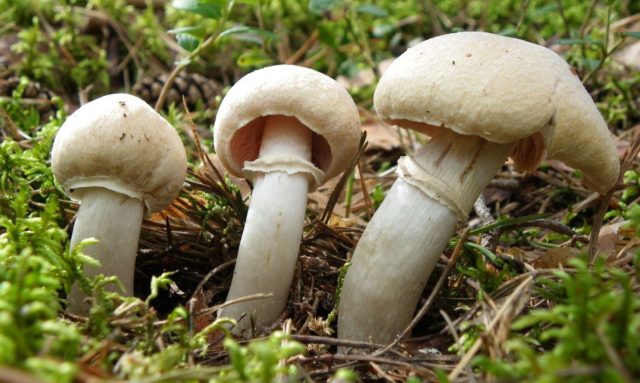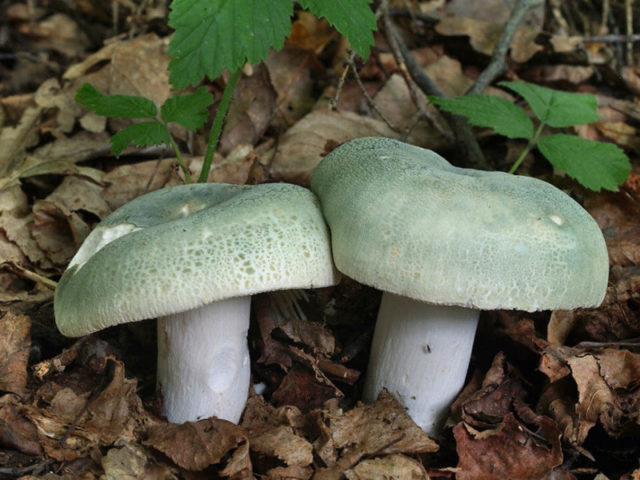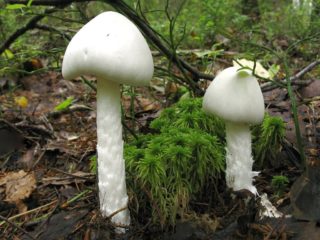Content
- 1 What does a pale grebe look like?
- 2 Where and when does the toadstool grow?
- 3 Why is the toadstool dangerous for humans?
- 4 Is toadstool used in folk medicine?
- 5 How to recognize a pale grebe
- 6 How to get rid of pale toadstool on the site
- 7 Conclusion
Among the many representatives of the mushroom kingdom, there is a separate category of mushrooms, the consumption of which poses an extreme danger to human health. There are not many such species, but anyone who is planning a “silent hunt” in the forest must know them by sight. Among these especially dangerous mushrooms is the toadstool, a photo and description of which are presented below.
What does a pale grebe look like?
The pale grebe is a typical representative of the Amanitov (fly agaric) genus. They are characterized by a cap-footed umbrella shape with a long, even cylindrical stem and a rounded flat (egg-shaped at an early age) cap.
Pale grebe (green fly agaric, white fly agaric) is quite easily identified in the forest, however, cases of fatal poisoning by them occur regularly. Therefore, with the onset of the season, you need to be as careful and careful as possible when collecting mushrooms. The consequences of eating poisonous specimens can lead to the most tragic results.
Description of the cap
The small pale grebe is egg-shaped. As the mushroom grows, the cap begins to straighten, its edges rise more and more, the shape becomes semicircular or semi-oval, and then increasingly flat.Its diameter can reach 10-12 cm. The upper part of the cap is covered with smooth, light, dirty-greenish or olive skin; in the center its color is more saturated, on the periphery it is light, sometimes almost white. The edges are slightly curved downwards.
The photo below shows what a pale grebe looks like at various stages of fruiting body development.
The reverse side of the cap is white, the plates are clearly defined, smooth, soft, and do not grow together with the stem.
Description of the leg
The leg of the green fly agaric has a cylindrical or truncated-conical shape with a slight thickening downwards. Usually it is smooth, but may be slightly curved. Often reaches 15 cm in length and 2.5 cm in diameter. The color of the leg is white; a moire pattern may be present on the surface. The ring is located in the upper part of the leg, it is wide, filmy, flowing, and may disappear with age.
The volva (tuber-like thickening at the base of the stalk) is pronounced, white, lobed, usually up to half of it is in the ground.
What group of mushrooms does the toadstool belong to?
Among all the mushrooms that are dangerous to human life and health, the toadstool occupies a special position. She belongs to the third, most dangerous group. Its representatives do not just cause food poisoning or central nervous system disorders. This group contains deadly poisonous mushrooms, the consumption of which will lead to death.
What does a toadstool smell like?
Green fly agaric does not have the specific mushroom smell characteristic of many other species. In some specimens it may be weak, slightly sweet, vaguely reminiscent of raw potatoes. The smell largely depends on the area in which the mushroom grew, as well as on its age.
How does the toadstool reproduce?
The green fly agaric reproduces by spores. They are white and round in shape. Ripe spores are carried by wind and water. They are poisonous, like all parts of the fruiting body of the green fly agaric.
Where and when does the toadstool grow?
Pale grebe grows not only in Russia, but also in Europe, Asia, and also in North America. It is found in mixed or deciduous forests of the temperate climate zone. It often forms mycorrhiza with oak, as well as linden, beech, walnut, and other deciduous and broad-leaved trees. It is not found very often, it grows mainly in small groups, as well as single specimens.
The first mushrooms appear in mid-July, fruiting continues until October.
Why is the toadstool dangerous for humans?
Green fly agaric is recognized as one of the most dangerous mushrooms for humans. The lethal dose is approximately 1/3 of an adult mushroom, which is approximately 30 g. According to statistics, 90% of poisonings with toadstool result in the death of the victim. Even if a person is lucky and the dose of toxins is not fatal, the treatment will be difficult and lengthy, and the body may never fully recover.
The effect of the venom of the toadstool
The effect of toadstool on the human body is due to the toxic substances it contains. The pulp of its fruiting body contains the following toxins:
- Amatoxins (amanin, α, β, γ-amanitins, amanulin).
- Fallotoxins (phalloidin, phallizin, phallicidin, falloin).
All of them affect primarily the kidneys, as well as the liver, causing toxic hepatitis and subsequent necrosis.
Is there an antidote for toadstool
The following medications are used as antidotes for poisoning with toadstool:
- Benzylpenicillin.
- Silibinin (Legalon).
- Acetylcysteine.
Signs of poisoning by toadstool
Symptoms indicating possible poisoning by toadstool appear with a noticeable delay. The first signs may appear only after 6-24, and in some cases even 48 hours after the fungus enters the body. This makes it difficult to make a timely diagnosis and leads to the fact that most of the toxins contained in the fruiting bodies have time to be completely absorbed into the blood. Because of this temporary delay, immediate measures taken to save the victim are no longer as effective.
Here are the most typical primary symptoms and signs of toadstool poisoning.
- Periodic pain and cramps in the abdomen.
- Nausea, uncontrollable vomiting.
- Frequent diarrhea with mucous discharge, sometimes with blood.
- Confusion.
- Constant thirst.
Usually on the third day the victim’s health improves. However, this is a deceptive state; intoxication of the body continues at this time.
After 2-4 days, signs of liver destruction appear: jaundice, darkening of urine. The heartbeat quickens, the pulse becomes uneven, and signs of hypertension appear. The structure of the blood changes, it becomes thick and quickly clots. As a rule, death occurs on days 10-12 due to acute heart failure, kidney or liver failure.
What happens if you eat toadstool
The severity of the consequences for the human body when eating green fly agaric mushrooms directly depends on the amount of mushrooms eaten, as well as on the time that has passed since the toxins entered the body, the correctness and speed of taking measures to save the person.
However, practice shows that even qualified medical care in most cases does not help, and 9 out of 10 poisoned people die. A lethal dose of toadstool poisons for an adult is contained in one medium-sized mushroom. Toxins have a stronger effect on children; death in this case occurs within 1-2 days.
First aid for poisoning with toadstool
It is impossible to provide qualified medical care at home. Therefore, if you suspect poisoning with mushrooms (any kind, not necessarily toadstool), you should not treat yourself. It is necessary to call an ambulance or take the victim to the nearest hospital.
Before the doctors arrive, you need to do the following.
- Rinse the victim's stomach by making him drink a large amount of lightly salted or potassium permanganate-colored water, and then induce vomiting. Food samples should be preserved for mycological examination for correct diagnosis.
- Restore the water-salt balance of the victim’s body by giving him to drink Regidron solution or lightly salted water in small doses.
- Give the victim any available enterosorbent: activated carbon (0.5-1 g per 1 kg of the victim’s body weight), Polysorb-MP, Enterosgel, etc.
- Provide bed rest.
Are there any known cases of fatal poisoning by toadstool?
Unfortunately, cases of death after eating pale toadstools are recorded every year. The figure below shows statistics on mushroom poisoning in general:
Approximately 10% of total deaths are caused by eating green fly agaric mushrooms. It is difficult to give exact figures, since detailed statistics are not kept. The largest number of poisonings is recorded in the Central Black Earth region of Russia. For example, in the Voronezh region in 1992, 40 people died from mushroom poisoning, 23 of whom were children.
Cases of death after eating toadstool have also been recorded in other countries. The video below shows news stories from Belarusian TV channels dedicated to this topic.
Is toadstool used in folk medicine?
Information about the use of toadstool in folk medicine is vague and vague. Some sources contain information about the use of microdoses of the fungus as antidotes for the treatment of poisoning, but this practice is highly questionable. Traditional medicine does not attribute any beneficial properties to the green fly agaric, however, there is information about developments underway at the German Cancer Research Center. Scientists at this medical institution conducted a number of successful tests on mice, in which a toxin isolated from the green fly agaric, α-amanitin, was used to suppress cancer cells. Research in this area is ongoing.
How to recognize a pale grebe
The pallid grebe is highly variable, but visually identifying it is not difficult. To do this, you need to clearly know all its distinctive features. The main ones are a wide ring in the upper part of the leg and a large tuberous volva.
How does toadstool differ from other poisonous mushrooms?
The pale toadstool is similar in description to other fly agarics, especially the stinking and toadstool. However, white dotted growths on the cap, characteristic of many other Amanitidae species, do not always appear on the cap. In addition to external differences, the composition of toxic substances contained in the fruiting bodies also differs. The toxins in the fruiting bodies of the green fly agaric do not decompose during heat treatment and are not removed from the pulp during soaking, so the mushroom remains poisonous after any type of processing.
What edible mushrooms does the toadstool look like and how to distinguish them
When young, the toadstool bears a certain resemblance to some edible mushrooms. This is the reason why mushroom pickers make mistakes when harvesting. Therefore, it is very important to take your time during a “quiet hunt”, carefully examine the cut mushrooms and throw them away at the slightest suspicion. It must be remembered that if a toadstool gets into a basket with mushrooms, neighboring specimens will become infected and the entire crop will have to be thrown away.
How to distinguish a pale grebe from a cap
The annular cap, or bogwort, is a fairly common mushroom of the Arachnoid family.It is often found in Central Russia, as well as in the western regions. It has good taste and is a desirable prey for many mushroom pickers. Unlike the green fly agaric, its cap is semicircular in shape and does not become flat with age. It is slightly brown, with a pinkish tint, very much like an eggshell. The surface of the cap is covered with a powdery coating.
There are a number of other differences between the cap and the toadstool. The reverse side of the cap of the fly agaric becomes brown with age, while on the green fly agaric it always remains white. There are no white flakes or scales on the surface of the cap.
From champignon
The easiest way to distinguish champignons from toadstool is by the color of the plates on the bottom of the cap. In the green fly agaric they are always white and do not change color as the mushroom ages.
In a young champignon, the color of the plates is pink, and as the mushroom ages it becomes more and more brown.
From greenfinch
Greenfinch, or green ryadovka, is a lamellar edible mushroom of the Ryadovkov family. You can distinguish it from the pale toadstool by the following characteristics:
- The green row leaves are lemon or greenish-yellow in color. In the pale grebe they are always white.
- The shape of the greenfinch's cap is flat-convex. The green fly agaric has a bell-shaped one.
- The green row completely lacks a ring on the stem, and it itself is noticeably shorter.
The color of the green stem is yellow or yellow-green. The pale grebe has a white leg.
From greenish and green russula
Young specimens of pale grebe and green or greenish russula can be very similar. However, there are a number of differences between them:
- Russula completely lacks the ring on the stalk, characteristic of the green fly agaric, and also completely lacks a volva.
- The plates of the russula are fragile and brittle, and the leg is thicker and denser.
How to recognize toadstool when cooking
Unfortunately, there is no reliable way to determine the presence of toadstool toxins in mushroom broth.
Methods based on changing the color of the broth that remains after boiling mushrooms, darkening a silver spoon placed in it, turning onions or garlic blue, etc. will not give a 100% guarantee, so they cannot be used. The most effective measure to avoid poisoning is to completely stop eating mushrooms at the slightest suspicion of the presence of green fly agarics among them.
How to get rid of pale toadstool on the site
Pale toadstool can sometimes grow in the garden or plot. You need to get rid of it as quickly as possible. All parts of the green fly agaric are poisonous, even the spores and mycelium. The mushroom must be removed from the ground, and the soil in the area where it grew must be turned over so that the mycelium threads remain open. So they will quickly be destroyed by the sun's rays. After this, the area must be completely dug up. To prevent mushrooms from appearing again, the soil is treated with a 0.2% solution of copper sulfate.
Often, mushrooms develop in places with abundant litter of fallen leaves, branches and dry grass. To prevent this from happening, you need to remove plant debris and old rotten wood in a timely manner. The soil in shaded areas needs to be loosened regularly to prevent high humidity.
Conclusion
Pale toadstool, a photo and description of which is given in the article, is one of the most poisonous mushrooms in the world. Perhaps in the future scientists will find a way to use the substances contained in it for the benefit of humanity, but so far this has not happened. Therefore, you need to pick mushrooms as carefully as possible and under no circumstances eat those that resemble the green fly agaric.
























